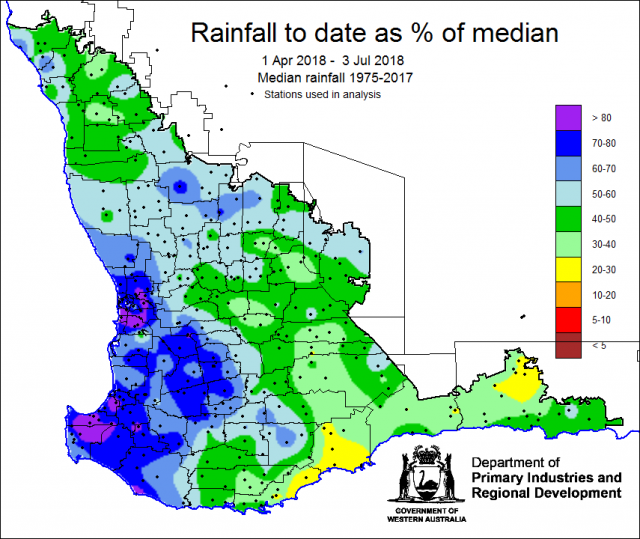Recent climate
June rainfall was below average for the grainbelt and April to June rainfall was very much below average. The SSF model indicated below normal rainfall was likely over the southern grainbelt in the April Seasonal Climate Outlook. June maximum temperatures were average to above average and minimum temperatures generally average. The rainfall to date map for 1 April to 3 July shows seasonal rainfall is well under median (compared to years 1975 to 2017) over south-eastern parts of the grainbelt in particular.
In June the atmospheric pressure was much higher than normal over southern Australia. The Indian Ocean sea surface temperatures northwest and west of Western Australia are near normal.
The Southern Annular Mode (SAM), also known as the Antarctic Oscillation (AAO), describes the north–south movement of the westerly wind belt that circles Antarctica, dominating the middle to higher latitudes of the southern hemisphere. SAM is currently near-neutral, sugegsting it is having little influence of rainfall over southern WA. The Bureau’s POAMA model indicates this status to continue through to mid-July.
The El Niño–Southern Oscillation (ENSO) remains neutral. However, climate model outlooks and recent warming in the tropical Pacific Ocean mean there is a greater than usual chance of El Niño forming later this year. The Bureau's ENSO Outlook is currently at El Niño WATCH, which means the likelihood of El Niño forming in 2018 is approximately 50%; double the normal chance. The Indian Ocean Dipole (IOD) is also currently neutral and all six models are indicating it to remain neutral until November. See the Bureau of Meteorology’s IOD and Pacific Ocean interaction for details.
When major climate drivers are at neutral values, regional rainfall may be affected by more local climate conditions rather than larger-scale features. Projections of seasonal rainfall may also be variable between different models.
The table below gives a summary of past month and three month south-west Western Australia (SWWA) climate conditions, and can be used as an indication of what is likely to occur in the near future, if climate conditions follow the current pattern.
| Climate indicator | Past month | Past three months |
| SWWA Rainfall | Below average | Very much below average |
| SWWA Mean Temperature | Average to above average | Above average |
| SWWA atmospheric pressure | Much higher | >Higher |
| Indian Ocean Sea surface temperature | Near normal | Near normal |
| El Niño/Southern Oscillation (ENSO) | Neutral | Neutral |
| Indian Ocean Dipole (IOD) | Neutral | Neutral |
| Southern Annular Mode (SAM) | Near neutral | Near neutral |

